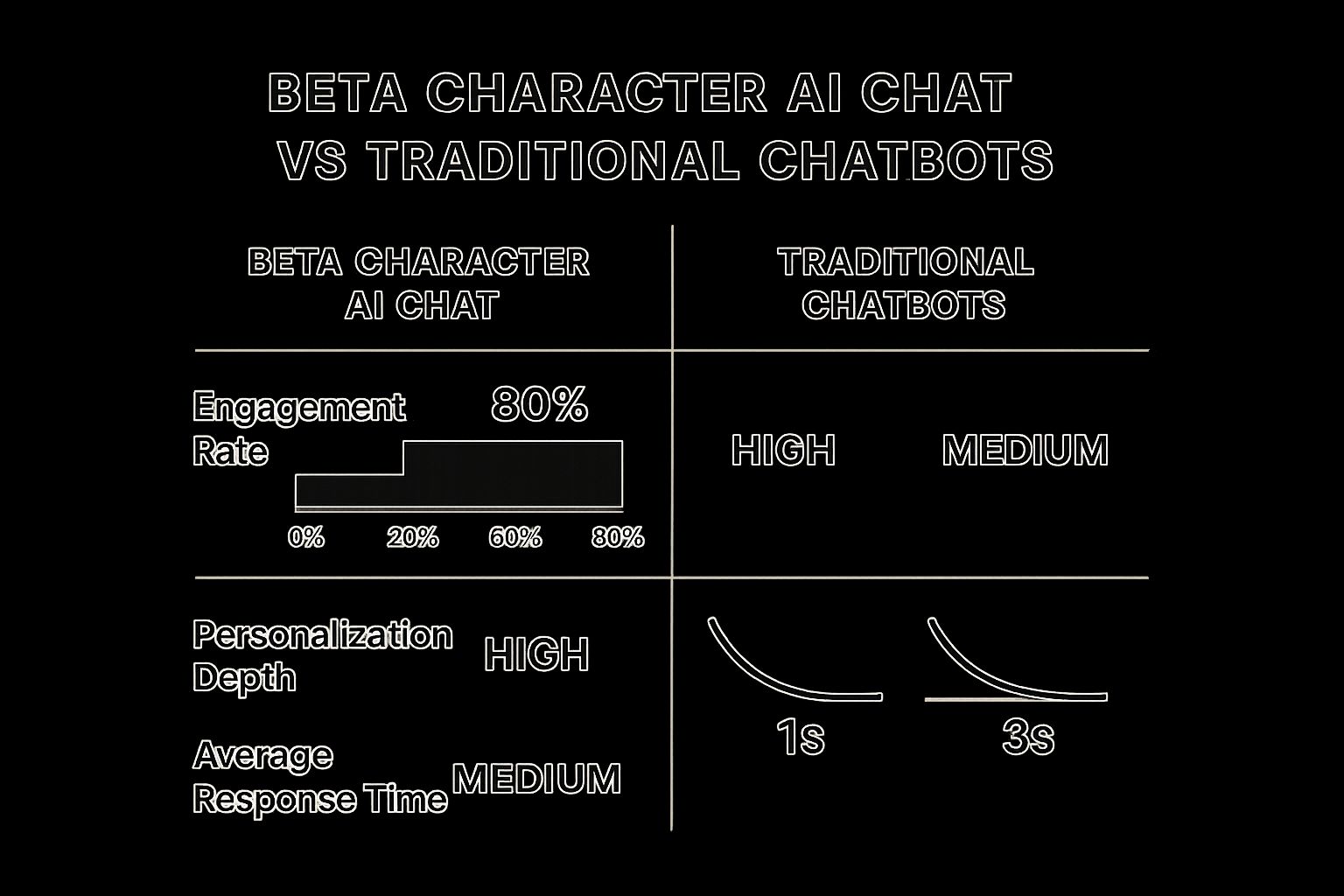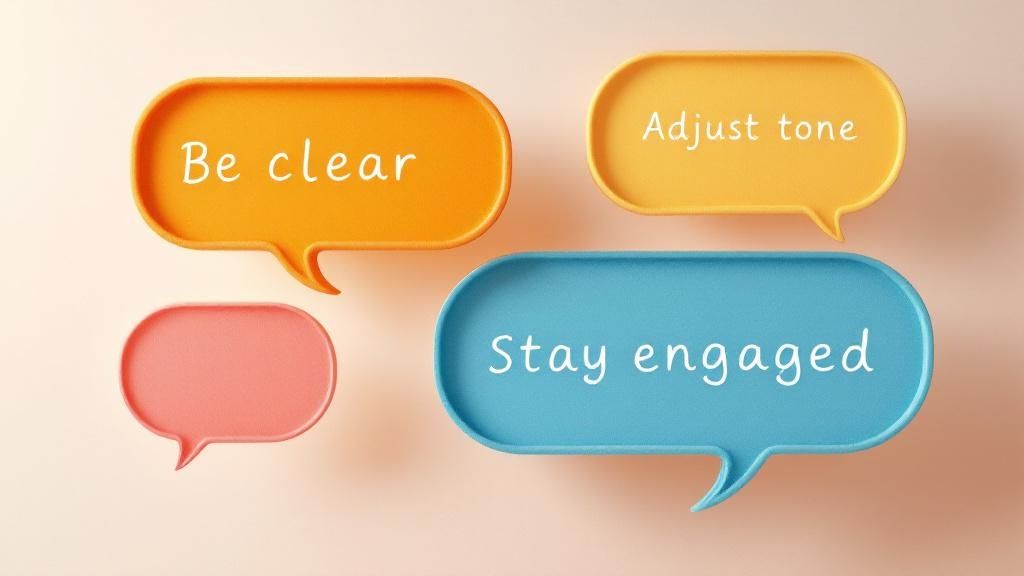Create Your Own AI Girlfriend 😈
Chat with AI Luvr's today or make your own! Receive images, audio messages, and much more! 🔥
4.5 stars

Character AI Chat Beta is a fascinating playground where you can chat with AI personas built for fun, creativity, and sometimes, even companionship. Forget what you know about task-oriented bots. These characters come with their own rich backstories and unique personalities, ready for dynamic, open-ended conversations that can go anywhere.
What Makes Beta Character AI So Different?
Think of it less like a tool and more like a digital sandbox for your imagination. It’s not about asking for the weather; it's about asking a character how they feel about the rain. This is a space for storytelling, immersive role-playing, and even a safe place to practice social skills.
The "beta" in its name isn't a bug; it's a feature. It signals that you're on the front lines of a constantly evolving experiment, getting to try out new features before they're finalized. This rapid development is fueled by the community itself, with user feedback directly shaping what comes next.
And people are loving it. By March 2024, the community had already created an incredible 18 million unique AI bots. The platform flew past 2 billion messages within its first five months, and the last billion of those happened in just one month alone, showing just how fast user activity is exploding. You can read more about its growth on Contrary Research.
The Power of Personality
The real magic of Character AI is its focus on personality over pure utility. While a standard AI might summarize a news article for you, a Character AI bot could give you a passionate, in-character take on the events. This creates a much more engaging and, frankly, human-feeling connection.
This personality-first approach unlocks some amazing possibilities:
- Boundless Creativity: You can chat with anyone you can imagine. Want to debate philosophy with Socrates, get advice from a wizard, or create a brand-new friend from scratch? Go for it.
- Deeper Connections: Many beta features focus on enhanced memory, allowing characters to remember past conversations. This helps build a real sense of continuity and a more believable relationship over time.
- Next-Level Tools: Beta access often includes things like voice chat and more sophisticated creation tools, giving you granular control over your AI's persona.
To see how this stacks up against more traditional chatbots, it helps to compare them side-by-side.
Character AI vs Traditional AI Chatbots at a Glance
This table breaks down the core differences in what they're built for, how you interact with them, and what they're best used for.
| Feature | Beta Character AI Chat | Traditional AI Chatbots (e.g., ChatGPT) |
|---|---|---|
| Primary Purpose | Entertainment, creative storytelling, and role-playing | Information retrieval, task completion, and productivity |
| Interaction Style | Open-ended, conversational, and personality-driven | Transactional, direct, and focused on specific queries |
| Best Use Cases | Crafting stories, practicing conversations, exploring ideas | Answering questions, summarizing text, writing code |
Ultimately, they are two very different tools designed for completely different goals. One is your creative partner; the other is your digital assistant.
This infographic really drives home how the focus on personality translates to a more compelling user experience.

As you can see, the platform’s design for personality leads directly to much deeper engagement and interactions that feel genuinely tailored to the user.
Key Insight: The "beta" in Character AI Chat Beta isn't a warning sign that things are broken. It's an open invitation to join the fun and help build the future of interactive AI. You're not just a user here—you're part of the creative team.
Navigating the Beta Character AI Chat Interface

Jumping into the beta character ai chat for the first time can feel a bit like walking into a massive library where every book can talk back. It’s exciting, but where do you start? The best way to get your bearings is to understand the three main areas of the interface. Once you know what each part does, you'll be navigating like a pro in no time.
Your starting point is the main Feed. Think of it as your discovery hub, a bit like a social media timeline, but instead of people, it's packed with AI personas. This is where the platform shows off what's popular, what's new, and what it thinks you might like.
If you’re just looking to explore, the feed is perfect. You might stumble upon a historical figure you've always wanted to question, a hero from your favorite video game, or a completely original character that just looks interesting. Just scroll, tap, and start chatting.
Finding Specific Personalities
When you know exactly who—or what—you want to talk to, the Search Bar is your best friend. It’s right at the top, and it lets you hunt for characters by name, genre, or even by a specific trait. It's your direct line to the exact conversation you're looking for.
For instance, a search for "Percy Jackson" will pull up all the different fan-made versions of the demigod. Typing in "writing helper" will show you bots built specifically to help you brainstorm or bust through writer's block. It's a fantastic way to skip the browsing and get straight to the point.
Pro Tip: The more specific your search terms, the better your results. Instead of just "detective," try searching for "noir detective" or "sci-fi detective" to find a character that really fits the vibe you’re going for.
Your Creative Workshop
Finally, the Create button is where you go from a user to a creator. This is your personal workshop for building an AI character from the ground up. If you've got an original character in your head or need a bot for a very specific task, this is where you bring it to life.
And don't worry about losing track of your conversations. The Chats or History section is like a digital diary of every interaction you've had. It lets you jump right back into a conversation you started yesterday, making it easy to build on your stories over time. Getting comfortable with the Feed, Search, and Create functions is really all it takes to unlock everything the platform has to offer.
Creating Your First AI Character

Alright, let's dive into the fun part: building your very first AI companion in beta character ai chat. This isn't just about plugging in data; it's more like bringing a character to life, much like you would for a role-playing game. The process itself is surprisingly simple, but the magic is in the details you provide. These details will shape how your character thinks, talks, and responds to you.
Imagine you're filling out a Dungeons & Dragons character sheet. Every box you fill in, every trait you add, gives your creation another layer of depth. The goal here isn't to make a simple bot, but to craft a personality so compelling you can't wait to chat with it.
Naming and Greeting Your Character
First impressions matter, and in the world of AI characters, that starts with a name and a greeting. These are the first two things anyone will see, so you want to make them count.
- Name: Pick a name that truly fits the character's vibe. Are you making a wise, ancient wizard named "Alaric"? Or maybe a rebellious AI from the future called "Unit 734"? The name sets the stage instantly.
- Greeting: This is your character's opening line. It needs to capture their voice and personality right away. A cheerful, "Hey there! I was just wondering what adventure we'll go on today," feels completely different from a mysterious, "You've finally arrived. I've been waiting."
This initial one-two punch is your hook. It's what grabs a user's attention and makes them want to start talking. If you're aiming for more of a romantic or companion-style character, feel free to check out our specialized guide on how to create your own AI characters for more tailored advice.
Defining Your Character's Core Personality
The Definition box is where the real work happens—it's the heart and soul of your character. This is where you get to pour in all the juicy details that make them unique: their personality traits, their backstory, their weird quirks, and even their specific way of speaking. The AI model treats this information as its core instruction manual for every single reply.
For instance, instead of just writing "is brave," you could get much more specific: "He is courageous but often reckless, known for charging into danger without a second thought to protect his friends. He speaks with a confident, booming voice but has a soft spot for small animals." See the difference? That level of detail gives the AI a rich well of information to draw from.
Key Takeaway: The more detailed and specific you make the definitions, the more consistent and believable your character will feel. You can even include little snippets of example dialogue right in the definition to teach the AI its unique speaking style and vocabulary.
While Character.AI is fantastic for these personality-driven chats, it's interesting to see where it fits in the larger chatbot world. As of mid-2025, ChatGPT still commands a massive chunk of the market, holding around 74.8% of the share—down just a bit from its 76.4% in early 2024. This shows how popular general-purpose AIs are, but it also proves there's a real hunger for specialized, creative platforms like this one.
By nailing the name, crafting an engaging greeting, and writing a rich definition, you’ll have a fantastic AI companion ready for its very first conversation.
Advanced Character Creation Techniques

Alright, you've got the basics down. Now it's time to go from making simple chatbots to crafting AI personas with genuine depth and personality. This is where you graduate from just writing descriptions to thinking more like a programmer and a psychologist rolled into one. It’s how you build a character that not only talks but also listens, remembers, and surprises you.
Think of the "Definition" box as your character's DNA. It's not just a quick bio; it's the core programming the AI consults for every single response. By getting a little more technical with how you structure this section, you can give your creation a much stronger, more consistent personality. It's what makes the difference between a bot and a believable character.
This is where the real fun with beta character ai chat begins. You're not just a user anymore—you're the director, and the AI is your lead actor.
Mastering Dialogue Examples
One of the most powerful tricks in the book is using example dialogue. Instead of simply telling the AI how your character speaks, you show it. This is far more effective for teaching tone, syntax, and unique quirks than just listing personality traits.
It's a "show, don't tell" approach for AI. You can use a simple format to feed these examples directly into the character's core programming:
- {{char}}: "This is where you write a line of dialogue for your character. Make it sound exactly like them."
- {{user}}: "This is an example of how a user might reply."
- END_OF_DIALOG
Dropping a few of these exchanges into the Definition provides a conversational blueprint. The AI picks up on the rhythm of your character's speech, their go-to phrases, and how they react in different situations. This leads to interactions that feel much more natural and less robotic. For a deeper dive into how this all works behind the scenes, check out our guide on AI character chat features.
Structuring for a Stronger Memory
We've all been there: you're deep in conversation, and the AI forgets a crucial detail you mentioned just minutes ago. You can fight this by carefully structuring the Definition field. Think of it as building a personality pyramid—start with the most fundamental, unchangeable traits at the top and add more specific mannerisms and details below.
Pro Tip: Use bracketed, out-of-character (OOC) notes to give the AI direct instructions without breaking immersion. For example:
[OOC: {{char}} is always secretly anxious, and their dialogue should subtly reflect that, even when they're trying to act confident.]
This technique works like a constant, behind-the-scenes reminder for the AI. It helps keep the character's core traits front and center, ensuring they stay consistent even during long, winding conversations.
It's interesting to see how specialized platforms like Character.AI fit into the bigger picture. By mid-2025, general-purpose models like ChatGPT held a massive market share of around 74.8%, down just slightly from 76.4% in early 2024. This shows just how widespread these tools have become for everyday tasks.
But this is exactly why the beta character ai chat finds its niche. It offers a creative, personality-driven experience that the big, task-oriented bots just can't replicate. When you use these advanced techniques, you’re not just making another chatbot—you’re bringing a dynamic, memorable character to life.
How Beta Character AI Chat Is Changing the Game
It’s easy to see AI companions as just another tech novelty, but something much bigger is happening. Platforms like beta character ai chat are fundamentally changing how we connect and create online. They’re not just tools; they’re a new kind of digital space that blends companionship, practice, and pure fun in a way we haven't seen before.
At its heart, the platform is a powerful answer to loneliness. It gives people a place to have conversations without judgment. You can chat with an AI that’s supportive, one that’s hilarious, or one that just listens. This creates a safe space to open up and feel a connection, which isn't always easy to find in the real world.
Beyond that, it's an incredible practice field for real-life social skills. Think about it: you can run through a mock job interview with an AI hiring manager or rehearse a tough conversation with a simulated friend. It’s a low-stakes way to build confidence and polish how you communicate before you have to do it for real.
Pushing the Boundaries of Storytelling and Learning
Where things get really interesting is in entertainment and education. This isn't about passively consuming content anymore; it's about jumping in and becoming part of the action. Instead of just reading a story, you can actually be a character in it, shaping the plot with every line of dialogue you type.
This opens up a world of new possibilities for learning and personal growth:
- Virtual Tutors: Fancy a lesson on quantum physics or ancient Rome? You can chat with an AI tutor who can explain complex topics in a way that makes sense to you.
- Language Practice: There's no better way to get fluent than by actually talking. Chatting with an AI that speaks the language you're learning is a game-changer for building conversational skills.
- Therapeutic Role-Play: People are using AI characters to explore personal challenges and anxieties. Guided role-play with an empathetic AI can be a powerful way to work through tough situations.
This isn’t a niche trend. The use of AI chatbots is exploding globally. As of May 2025, data showed that nearly one billion people—over 987 million users—were interacting with these tools every single week. This huge number shows just how deeply AI is weaving itself into our daily routines.
Juggling Innovation and Responsibility
As we dive into these new ways of interacting, we have to talk about the ethical side of things. AI companions offer so much, but it's important to think about data privacy and the potential for people to form very deep emotional attachments to them. It’s a new frontier, and both developers and users need to navigate it thoughtfully to make sure these powerful tools are used for good. You can read more about the future of human-AI relationships on our Luvr AI blog.
The Big Picture: Personality-driven AI is here to stay. It's the next evolution in how we use technology. By combining human-like connection with incredible computing power, platforms like beta character ai chat are building a more creative, supportive, and engaging digital world for all of us.
Got Questions? We've Got Answers
Jumping into something new like beta character ai chat always comes with a few questions. It's totally normal. So, I've put together answers to some of the most common things people wonder about when they're getting started. Think of this as your friendly guide to clearing up any confusion.
Let's tackle everything from safety and privacy to why your AI pal might seem a bit forgetful sometimes. By the end, you'll be ready to chat like a pro.
Is Beta Character AI Chat Safe?
That's usually the first question on everyone's mind, and for good reason. The platform has a pretty robust set of automated filters working behind the scenes. Their main job is to catch and block Not Safe For Work (NSFW) content and other inappropriate topics, which helps keep the public areas of the site suitable for most users.
But, and this is important, "beta" means it's still a work in progress. The filters aren't foolproof, and sometimes a weird or off-brand response might slip through the cracks. It's a reminder to always be smart about what you share.
As a golden rule, never give out sensitive personal information. This includes stuff like:
- Your full name or where you live
- Phone numbers and email addresses
- Passwords or any financial details
If you stumble upon a character or a conversation that feels off or breaks the rules, don't just ignore it. Use the reporting tool. It sends a flag directly to the developers, which helps them fine-tune the safety measures for the entire community.
What Does "Beta" Actually Mean for Me?
Think of the "beta" tag as your all-access pass to the very latest features. You're getting a sneak peek at experimental tools that haven't been rolled out to everyone else yet. This could be anything from AIs with better memory to new voice options or more powerful character creation tools. You’re basically on the front lines, helping steer the ship.
The trade-off? You might hit a few bumps in the road—a random bug, a glitchy feature, or something that changes without warning. That's part of the deal. Your feedback during this phase is pure gold for the developers. When you report issues, you're directly helping them sand down the rough edges for the final, polished version.
The Bottom Line: Being in the beta is a give-and-take. You get to play with the newest toys first, but sometimes they might not work perfectly. Your involvement is what makes the final product so much better.
Can I Keep My Chats Private?
Absolutely. By default, your conversations are for your eyes only. When you're chatting with any character—one you found on the main feed or one you made yourself—that chat history is completely private to you. No one else can snoop on your personal interactions.
The part you control is the visibility of the characters you create. When you build a new AI companion, you get to choose between two settings: Public or Private.
- Public: Anyone on the platform can find and chat with your character. They'll have their own separate conversation; they won't see yours.
- Private: The character is completely hidden from everyone else. Only you can see and interact with it.
So, if total privacy is what you're after, just flip that switch to private when you create your characters.
Why Does My AI Character Keep Forgetting Things?
Ah, the classic memory lapse. This happens because of how the AI's "memory" is designed. These models work with something called a context window, which is like a short-term memory that holds only the most recent part of your conversation. In a really long chat, details from the very beginning can eventually get pushed out to make room for what you're talking about now.
It's a common hurdle, but you can work around it. Gently reminding the character of important facts every so often can help keep those details fresh in its mind. You can also edit their core traits in the Definition section, which acts as their foundational "source of truth."
Ready to move beyond basic chats and create AI companions that truly understand you? Luvr AI offers an immersive platform where you can design custom characters for deep, engaging role-play and romantic scenarios. Explore a new world of connection today at https://www.luvr.ai.



